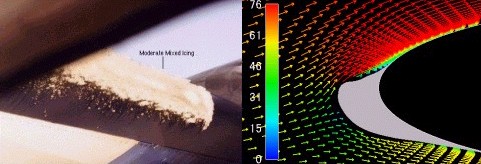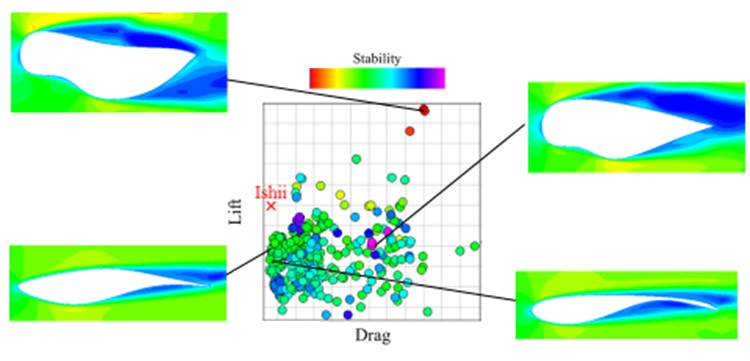Aerospace
1.Numerical Simulation of Ice Accretion Phenomena

We use numerical simulation to predict icing phenomena occurring in aircraft. The icing phenomenon of an aircraft is a phenomenon in which supercooled liquid droplets in the atmosphere adhere to the wing as ice when flying over low temperature air. As the flight performance deteriorates and the operation is dangerous, safe flight operation becomes possible if accurate prediction is possible. The icing phenomenon is caused by supercooled liquid droplets of various sizes, but it is particularly dangerous if the droplet is large, since the amount of ice that adheres increases. Therefore, focusing on the characteristic phenomenon occurring when the droplet is large, we aim to reproduce the ice shape. Also, we are studying how the unique phenomenon affects the ice shape.
2.Numerical study of aircraft anti-icing system technology

In the environment below the freezing point, the phenomenon "icing" occurs when ice adheres to the surface of the aircraft. The icing phenomenon leads to deterioration of aircraft performance, so it is one of the problems that the airline industry has. In recent aircraft such as B787, various icing countermeasures are taken. Especially, anti-icing measures by electric heaters are attracting attention as icing countermeasures which are superior in view of environmental and functional aspects. However, more practical knowledge such as optimum temperature setting and installation range to prevent icing is not obtained much. Therefore, in this research, we aim to obtain these findings by simulating icing.
3.Multi-Objective Design Exploration of Airfoil for Tailless Airplane

Mars is a powerful candidate as an extraterrestrial settlement, and Mars is being explored in the world. Investigation using Mars Rover and artificial satellite etc has mainly been done so far, but exploration using an airplane has been devised as a new method. The planned Mars airplane has an outline of a general aircraft with tail wings, but a Martian airplane without horizontal tailplane is simple in shape and easy to transport to Mars Mars airplane It is considered as one of the candidates. In this research, we explore the characteristics of wing suitable for Martian aircraft without horizontal tail fin, using numerical calculation and evolutionary calculation.
4.Experimental Study on the Acoustic Waves Emitted from Supersonic Jet

When launching the rocket, a very strong noise (acoustic wave) is generated from the exhaust of the rocket engine (supersonic jet). This acoustic wave may vibrate the payload and destroy it. In the current acoustic vibration test, the prediction accuracy of the acoustic wave is not sufficient and it has enormous cost. In response to this, research on acoustic wave prediction by CFD has been actively conducted. Our laboratory aims to analyze the supersonic jet closer to the real thing by large scale computation using supercomputer and to capture the acoustic wave more accurately. In addition, we are also conducting experimental approaches to verify the difference between actual physical phenomena and current CFD. By using suction type compact supersonic wind tunnel in JAXA / ISAS, we obtain experimental data of high-definition supersonic jet and compare it with CFD data to aim for elucidation of acoustic wave generation mechanism.
5.Flow Field Analysis on Acoustic Panel of Fan Duct in Jet Engine
In an aircraft having a turbofan engine, a noise reduction panel is installed in the duct as a measure against noise. However, this muffler panel has been established based on the experience of engineers, and the detailed mechanism has not been elucidated. However, it is difficult to see the detailed flow such as the inside of the silencer panel, in addition to having very large equipment for analysis by experiment. Therefore, our purpose is to clarify the detailed flow field by computer analysis. Since the Mach number in the main flow duct and the inside of the sound deadening panel are significantly different, it is difficult to analyze with the conventional compressible solver. Therefore, we solve this problem by using forward speed correspondence scheme and try to analyze in actual operation conditions.
